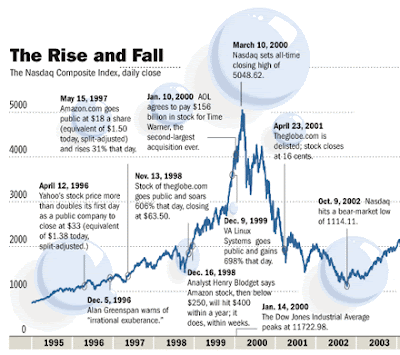Anyone reading this blog will most likely either have been
sat in Professor John Turners lecture last week, or will in fact be John
Turner, and so you should be aware that there are main 3 causes of asset
bubbles. Just in case someone who isn’t from the risk management class has
stumbled upon this blog and wasn’t in the class, the 3 causes put forward in
the lecture were:
1) Agency costs associated with borrowed money
2) Technological Revolutions
3) Investor-Deceiving Frauds
2) Technological Revolutions
3) Investor-Deceiving Frauds
In class I came to the conclusion that there was no single
cause for a bubble, but rather it is usually a mixture that contributes. Of the
reasons above, the technological revolution jumps out as the obvious answer to
the cause of this bubble. The rapid uptake in use of the internet was seen by
many as being the start of a “new era”, and this mentality will certainly have
contributed to the growth of the bubble. However, another theory I would
suggest is that it might have been a form of Investor-Deceiving Fraud.
Hickson and Turner (2006) argued that governments might be
responsible for bubbles because of a threat of imminent revolution, or because
of a diminished concern for the middle class. It is the second theory here that
I think should be considered.
The Private Securities Legislation Reform Act (1995) was
designed to restrict the ease with which lawsuits could be brought against
firms over claims about performance. The problem this Act created is that it is
very difficult to actually prove a company is making an over-hyped statement,
and so in effect, this Act may have encouraged firms to make outlandish
statements as they were protected from potential litigation. The growing prevalence
of the internet made it very easy to hype up stock prices, and with the
protection of the PSLRA, many firms did exactly this.
 |
| One of the many casualties of the dot-com bubble bursting |







